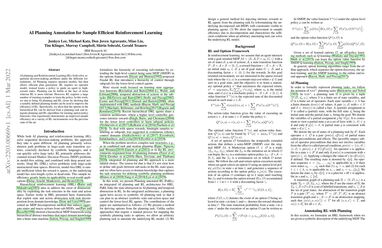Hierarchical Reinforcement Learning with AI Planning Models
Two common approaches to sequential decision-making are AI planning (AIP) and reinforcement learning (RL). Each has strengths and weaknesses. AIP is interpretable, easy to integrate with symbolic knowledge, and often efficient, but requires an up-front logical domain specification and is sensitive to noise; RL only requires specification of rewards and is robust to noise but is sample inefficient and not easily supplied with external knowledge. We propose an integrative approach that combines high-level planning with RL, retaining interpretability, transfer, and efficiency, while allowing for robust learning of the lower-level plan actions. Our approach defines options in hierarchical reinforcement learning (HRL) from AIP operators by establishing a correspondence between the state transition model of AI planning problem and the abstract state transition system of a Markov Decision Process (MDP). Options are learned by adding intrinsic rewards to encourage consistency between the MDP and AIP transition models. We demonstrate the benefit of our integrated approach by comparing the performance of RL and HRL algorithms in both MiniGrid and N-rooms environments, showing the advantage of our method over the existing ones.
PDF Abstract

